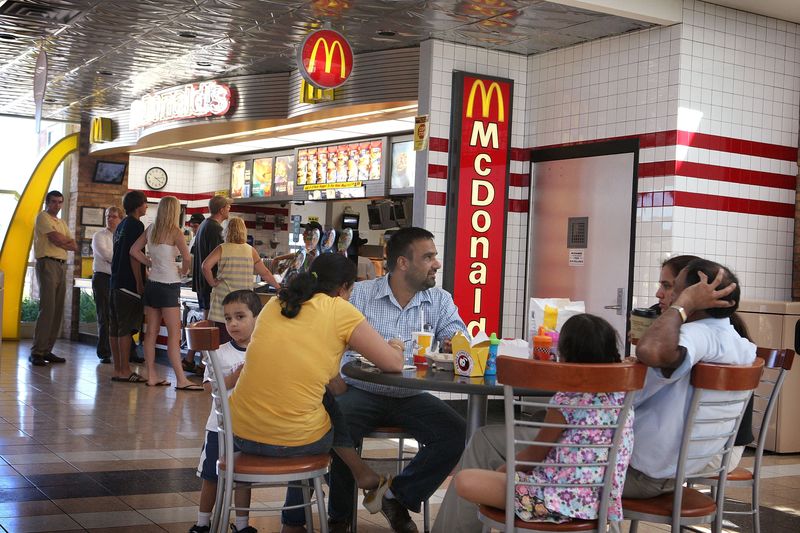In October, Uber-owned Otto announced that it had completed the first commercial driverless truck delivery in Colorado. In November, McDonald’s announced that it was rolling out touchscreen ordering systems nationwide. Now, Amazon is opening a new convenience store with no checkout lines and no cashiers.
Add it all up, and it looks like an apocalyptic future for low-skilled workers. Cashiers and fast food workers are near the top of the government’s list of the jobs that employ the most people in the United States, with 3.3 million and 2.9 million workers working at these jobs, respectively. Truck drivers account for another 1.6 million jobs.
And even before these latest innovations hit the market, the data showed declining employment among less-educated workers — especially men. In a September post, economist Larry Summers wrote that if recent employment trends continue, “by mid-century about a quarter of men between 25 and 54 will not be working at any moment.”
At the same time, economists are having another debate that might seem unrelated but is actually hugely relevant to this question about the future of jobs. In an August blog post, Summers warned the Fed not to raise interest rates in September. (The Fed kept rates unchanged in September but may raise rates at its meeting next week.) He followed up with a post warning that low interest rates may leave the Fed unable to adequately support the economy during the next recession.
Summers doesn’t draw a connection between these posts, but these are really two ways of looking at the same problem. When society invents a new technology that makes workers more efficient, it has two options: It can employ the same number of workers and produce more goods and services, or it can employ fewer workers to produce the same number of goods and services.
Jargon-filled media coverage makes this hard to see, but the Federal Reserve plays a central role in this decision. When the Fed pumps more money into the economy, people spend more and create more jobs. If the Fed fails to supply enough cash, then faster technological progress can lead to faster job losses — something we might be experiencing right now.
So if you’re worried that technological progress will lead to mass unemployment — and especially if you think this process is already underway — you should be very interested in what the Federal Reserve does. The Fed is widely expected to raise interest rates again at its meeting next week. But if it wanted to, it could cut rates instead, sparking a big economic boom that could help to reverse the declining employment of recent years.
Automation won’t destroy all the jobs — and it might even create some
/cdn0.vox-cdn.com/uploads/chorus_asset/file/7603709/82048497.jpg)
It seems clear that technological progress will eliminate a lot of jobs over the next couple of decades. Some people are worried that technology will eliminate all jobs — or at least all jobs that some classes of less educated workers are likely to get. But that misunderstands what’s going on.
Take McDonald’s, for example. The store is rolling out touchscreen kiosks that could eliminate some jobs taking orders at fast food restaurants. At the same time, McDonald’s doesn’t have a burger-flipping robot, so if fast food meals get cheaper it’s likely to attract more customers and create more jobs preparing the food.
McDonald’s has also been experimenting with table service, which could create some new jobs as the fast food giant tries to move a bit upscale. If that experiment fails, a lot of customers will move upscale anyway. Last year, consumer spending on dining out overtook spending on groceries. As society gets richer, people are spending more and more money on dining out in general and upscale dining in particular. And the more upscale options are inherently labor-intensive. People might be okay with ordering McDonald’s on a touchscreen, but nobody is going to take a date to an automated fast food restaurant.
At the same time, we’ve seen huge growth in demand for workers in labor-intensive fields like education, medicine, child care, and elder care. Some of these jobs require a lot of education (like professors and doctors), some are middle-skilled jobs (nurses, barbers, and schoolteachers) while others (nannies and home health aides) require relatively little training. And none of them are in immediate danger of being automated, since the jobs inherently involve interacting with other people.
The key thing to note here is that there isn’t a fixed number of jobs that have to be parceled out. Lots of people would like their kids to go to schools with smaller student-teacher ratios. They struggle to find affordable child care. They’d like to eat out more. They’d like to have more cops on the beat in their neighborhoods. They’d like their kitchens remodeled, their lawns mowed, and their taxes prepared. There’s lots of work that society would, collectively, like to have done.
If you want more jobs, give people more money
/cdn0.vox-cdn.com/uploads/chorus_asset/file/7603735/475636695.jpg)
At any given point in time, the economy is creating a lot of jobs even as it destroys a lot of other jobs. The big question is whether the economy can create more jobs than it destroys overall. The economy needs to create around 150,000 jobs per month just to keep up with population growth. In the past few years, we’ve been doing a bit better than that, with about 200,000 jobs being created in a typical month.
But that topline figure actually masks huge churn in the labor market. In October 2016, for example, employers hired 5.1 million new workers, while 4.9 million workers quit or were fired or laid off.
This means it can be misleading to worry too much about job losses in any specific sector of the economy. If job destruction speeds up, that’s not a problem so long as job creation speeds up at least as quickly.
And fundamentally, the key to job creation is consumer spending. If consumers spend more, companies will need to hire more people to keep up with demand.
The Federal Reserve has a simple and effective way to get consumers to spend more: putting more money in their pockets. The Fed does this in a somewhat convoluted way — conventionally, they buy government bonds, lowering interest rates in the process — but the practical effect isn’t that different from directly giving people money. As people have more cash on hand, they become more inclined to spend more of it and spending goes up.
Almost everyone agrees with this analysis during a recession like we had in 2009. It becomes more controversial during periods when the economy is stronger, like right now. The conventional view holds that if the Fed tried to boost the economy more at its meeting next week, we’d just get more inflation, not more employment.
But there’s reason to doubt this view. The share of “prime age” workers (those between ages 25 and 54) who have jobs was 80 percent in 2007 and almost 82 percent in 2000. Today, it’s just 77 percent. That suggests that there are millions of workers who could be drawn back into the workforce if the Fed gave us the kind of economic boom that got prime age employment above 80 percent in the late 1990s.
Narayana Kocherlakota, an economist who was president of the Minneapolis Fed from 2009 to 2016, has become a leading voice for the view that easier money could boost the economy and draw more workers into the workforce. In an October speech, Fed Chair Janet Yellen signaled that she wasn’t yet persuaded by these arguments, but she was taking them seriously.
Geography makes monetary stimulus more difficult
Other writers who have pondered this problem believe that it’s not so easy. The Economist’s Ryan Avent, for example, wrote a whole book about the challenges new technologies are creating for the labor market. Avent does talk about monetary policy late in his book, but he treats it as a fairly peripheral issue, and isn’t optimistic about its prospects for offsetting automation-driven job losses.
One important reason for this is geography. The declining sectors of the economy and the growing sectors of the economy are not necessarily in the same metropolitan area — and most service sector jobs require the customer and the provider to be in the same place. A lot of towns in the Rust Belt are declining, for example, while Silicon Valley is booming. So it’s possible that easier money would mostly create more jobs in places like Silicon Valley and New York where a lot of normal people can’t afford housing.
I think that’s a valid concern, but it’s also somewhat overblown. If overall spending went up, that would partly lead to a higher demand for barbers in Manhattan and fine dining in Palo Alto — demand that might be impossible to meet given high housing costs in those places. But it would also lead to more demand for cars and steel and machine tools that are produced in the Rust Belt. Declining towns near major cities would see higher tourism revenue as city dwellers took day trips to historical sites and stayed at bed and breakfasts in the countryside.
Perhaps most importantly, looser money could create booms in second-tier cities like Minneapolis, St. Louis, and Philadelphia where there are significant local industries but housing costs have not yet become astronomical. People who can’t find work in rural Missouri, Pennsylvania, Minnesota, or Wisconsin could find jobs as nurses, police officers, or barbers in nearby cities.
A booming economy won’t help everyone who’s stuck in a declining town. There are some laid off 55-year-old factory workers who just aren’t going to move to a new city to start a second career as a barber or nurse. But it would help a lot of people, especially young people who have the most to lose from a life of under-employment.
A final possibility is that the Fed will be unable to boost the economy because interest rates are already at zero. Many, though not all, economists believe that monetary policy becomes ineffective at this point because interest rates can’t go any lower. Rather than dig into that complicated debate, I’ll just note that right now interest rates are not zero, and the Fed is even thinking about raising rates. So whether or not you think the Fed was powerless to do more in 2009, it’s definitely not powerless today.
[Source:-Vox]







